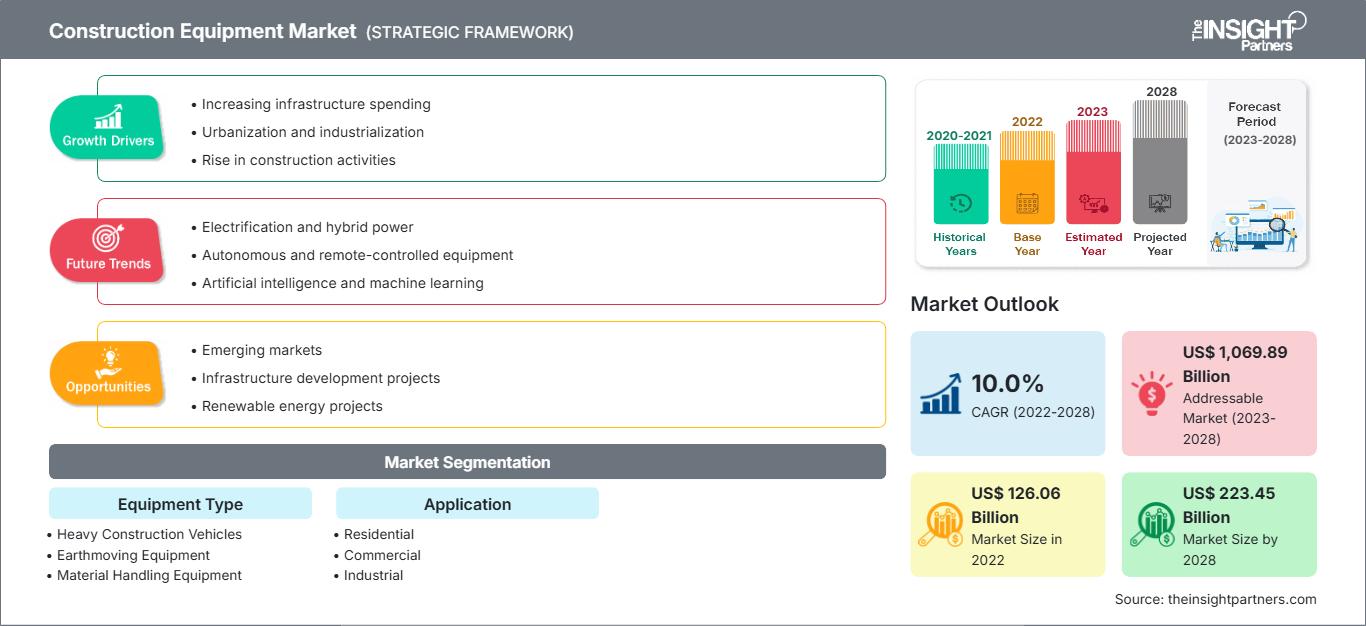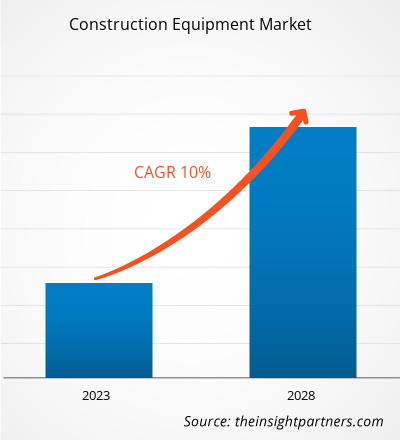Der Markt für Baumaschinen soll von 126.062,8 Millionen US-Dollar im Jahr 2022 auf 223.451,1 Millionen US-Dollar im Jahr 2028 wachsen; die durchschnittliche jährliche Wachstumsrate (CAGR) von 10,0 % wird für den Zeitraum von 2022 bis 2028 geschätzt.
Schwerlastfahrzeuge, die speziell für Bauarbeiten, meist Erdarbeiten, entwickelt wurden, werden als Baumaschinen bezeichnet. Der richtige Einsatz geeigneter Geräte trägt zur Wirtschaftlichkeit, Qualität, Sicherheit, Geschwindigkeit und Termintreue des Projekts bei. Es ist nicht immer erwünscht oder machbar, dass ein Auftragnehmer über alle für das Projekt benötigten Baumaschinen verfügt. Aushub, Erdaushub, Erdbewegung über große Entfernungen, Platzierung, Verdichtung, Einebnung, Planieren, Planieren und Transportieren gehören zu den wichtigsten Prozessen bei der Durchführung eines Bauprojekts. Verschiedene Erdarbeiten wie Aushub und Erdbewegung werden mit Erdbewegungsmaschinen durchgeführt. Erdbewegungsmaschinen gibt es in verschiedenen Formen und Größen. Sie werden hauptsächlich für Reparatur-, Bau-, Hebe-, Landwirtschafts- und Abbrucharbeiten eingesetzt. Bagger sind Erdbewegungsmaschinen mit Schaufeln, Armen, drehbaren Kabinen und beweglichen Ketten. Ein Baggerlader, auch Heckbagger oder Heckbagger genannt, ist ein Aushubgerät mit einer Baggerschaufel am Ende eines zweiteiligen Gelenkarms. Ein Lader ist eine Baumaschine, die Materialien wie Asphalt, Abbruchabfälle, Erde, Schnee, Futtermittel, Kies, Baumstämme, Rohmineralien, Recyclingmaterial, Gestein, Sand und Holzspäne in oder auf andere Maschinen bewegt oder lädt.
Passen Sie diesen Bericht Ihren Anforderungen an
Sie erhalten kostenlos Anpassungen an jedem Bericht, einschließlich Teilen dieses Berichts oder einer Analyse auf Länderebene, eines Excel-Datenpakets sowie tolle Angebote und Rabatte für Start-ups und Universitäten.
Baumaschinenmarkt: Strategische Einblicke

- Holen Sie sich die wichtigsten Markttrends aus diesem Bericht.Dieses KOSTENLOSE Beispiel umfasst Datenanalysen, die von Markttrends bis hin zu Schätzungen und Prognosen reichen.
Sie erhalten kostenlos Anpassungen an jedem Bericht, einschließlich Teilen dieses Berichts oder einer Analyse auf Länderebene, eines Excel-Datenpakets sowie tolle Angebote und Rabatte für Start-ups und Universitäten.
Baumaschinenmarkt: Strategische Einblicke

- Holen Sie sich die wichtigsten Markttrends aus diesem Bericht.Dieses KOSTENLOSE Beispiel umfasst Datenanalysen, die von Markttrends bis hin zu Schätzungen und Prognosen reichen.
Wichtige Akteure auf dem Baumaschinenmarkt sind Baumaschinenrohstoffe, Baumaschinenhersteller auf der Angebotsseite und Baumaschinenendnutzer auf der Nachfrageseite. In den letzten Jahren ist die Nachfrage nach Baumaschinen, insbesondere im Wohnungs- und Gewerbebau, gestiegen, was das Marktwachstum in den nächsten fünf Jahren voraussichtlich vorantreiben wird. Caterpillar, John Deere, Komatsu, Volvo und Liebherr gehören zu den wichtigsten Baumaschinenanbietern. Neben diesen wichtigen Akteuren des Ökosystems gibt es mehrere weitere periphere Akteure, die eine entscheidende Rolle bei der Ermöglichung technologischer Fortschritte und der Einführung dieser Produkte in verschiedenen Branchen spielen.
Auswirkungen der COVID-19-Pandemie auf den Baumaschinenmarkt
Im Jahr 2020 behinderte die COVID-19-Pandemie die Bautätigkeit. Infolgedessen gingen die Baumaschinenverkäufe weltweit zurück. Infrastrukturinvestitionen, Wohnungs-, Gewerbe- und Industriebau, Tiefbau und Brunnenbau sowie institutionelle Ausgaben wirken sich auf die Baumaschinenhersteller aus. Die USA, Großbritannien, China und Indien gehören zu den Ländern, die überproportional betroffen waren. Laut der International Construction Group verzögerte sich die Fertigstellung von über einem Viertel aller Projekte (22,7 %) um mehr als 250 Tage und bei über einem Zehntel aller Projekte (13,4 %) um mehr als ein Jahr im Jahr im Jahr 2020. Projekte für Krankenhäuser und andere medizinische Einrichtungen, Labore sowie Schifffahrts- und Logistikinfrastruktur sind jedoch nur begrenzt verfügbar. Darüber hinaus haben mehrere Länder begonnen, ihre Aktivitäten in verschiedenen Branchen, einschließlich der Bauindustrie, schrittweise wieder aufzunehmen. Indien und China haben industrielle und gewerbliche Bauprojekte gestartet. Im April 2021 stieg die Industrieproduktion zum ersten Mal seit Januar 2021, da die Länder mit der Umsetzung neuer Projekte begannen. Daher stieg die Nachfrage nach Baggern, Baggerladern, Verdichtern, Planierraupen und anderen Baumaschinen sprunghaft an.
Markteinblick: Steigende Infrastrukturinvestitionen nach der COVID-19-Pandemie
Die Wirtschaftsaktivitäten auf der ganzen Welt wurden durch die COVID-19-Pandemie erheblich gebremst. In den Jahren 2020–21 wurden enorme Investitionen in die Infrastruktur getätigt, die dem Wachstum der Infrastrukturbranche Auftrieb verliehen. Infrastrukturinvestitionen in die Stromerzeugung, den Bau nationaler Autobahnen, den Schienenverkehr und die Frachtschifffahrt treiben die Nachfrage nach Baumaschinen an. In den Schwellenländern wiesen einige Kerninfrastrukturbranchen wie Kohle, Rohöl, Stahl und Zement im Jahr 2021 den Wachstumsindex auf. Diese Faktoren wirkten sich positiv auf das Wachstum des Baumaschinenmarktes aus. Infrastrukturinvestitionen wirken sich langfristig auf die Produktentwicklung aus, was das BIP langfristig steigern kann, wenngleich das Ausmaß dieser Effekte unbekannt ist. Die meisten Länder, insbesondere im Nahen Osten, haben ein quadrilaterales Wirtschaftsforum eingerichtet, das sich auf Infrastrukturentwicklungsprojekte in der Region konzentriert. Um die Kommunikation zwischen Mitarbeitern und mit Verbrauchern zu erleichtern, nutzen Unternehmen digitale Lösungen und Kanäle. Auch Regierungen und Bildungseinrichtungen haben dies getan.
Einblicke in das Segment der Maschinentypen
Aufgrund der wachsenden Zahl von Gewerbe-, Wohn- und Industrieprojekten, für deren Ausführung schwere Werkzeuge und Maschinen benötigt werden, werden mehr Baumaschinen eingesetzt als je zuvor. Bei Großprojekten werden schwere Baumaschinen für verschiedene Aufgaben eingesetzt. Die Wahl der richtigen Baumaschinen richtet sich nach Umfang und Kosten des Projekts. Diese Faktoren erleichtern und beschleunigen den Bauprozess. Bagger sind ein wichtiges und häufig eingesetztes Gerät im Bausektor.
Einblicke in Anwendungssegmente
Der Markt für Baumaschinen ist je nach Anwendung in Wohn-, Gewerbe- und Industriebereiche unterteilt. Asphaltmischanlagen werden zur Herstellung von beschichtetem Straßenschotter und anderen Asphaltbetonarten für den Straßenbau eingesetzt. Straßenwalzen sind im Wesentlichen verdichtungsartige Baumaschinen, die beim Bau von Straßen und Fundamenten Erde, Kies, Beton oder Asphalt verdichten. Für die Installation von Fertigpfählen für Wolkenkratzer und andere riesige Industriekomplexe, die tiefe Fundamente benötigen, werden Pfahlbohrmaschinen eingesetzt, um vertikale Löcher auf der Baustelle zu bohren, was zum Wachstum des Baumaschinenmarktes beiträgt. Die Akteure des Baumaschinenmarktes konzentrieren sich auf Produktinnovationen und -entwicklungen, indem sie fortschrittliche Technologien und Funktionen integrieren, um mit der Konkurrenz mithalten zu können. Im Juni 2022 gab Caterpillar Inc. bekannt, dass sein weltweiter Hauptsitz von Deerfield, Illinois, an den bestehenden Firmenstandort in Irving, Texas, verlegt wird. Das Unternehmen wird 2022 mit der Verlegung seines Hauptsitzes nach Irving beginnen. Basierend auf dem Gerätetyp ist der Markt für Baumaschinen in schwere Baufahrzeuge, Erdbewegungsmaschinen, Materialtransportgeräte und Sonstiges unterteilt. Der Markt ist basierend auf der Anwendung in Wohn-, Gewerbe- und Industriebereiche unterteilt. Basierend auf der Region ist der globale Markt für Baumaschinen in Nordamerika, Europa, Asien-Pazifik, Naher Osten und Afrika sowie Südamerika unterteilt.
Markt für Baumaschinen
Die Analysten von The Insight Partners haben die regionalen Trends und Faktoren, die den Baumaschinenmarkt im Prognosezeitraum beeinflussen, ausführlich erläutert. In diesem Abschnitt werden auch die Marktsegmente und die geografische Lage in Nordamerika, Europa, dem asiatisch-pazifischen Raum, dem Nahen Osten und Afrika sowie Süd- und Mittelamerika erörtert.Umfang des Marktberichts für Baumaschinen
| Berichtsattribut | Einzelheiten |
|---|---|
| Marktgröße in 2022 | US$ 126.06 Billion |
| Marktgröße nach 2028 | US$ 223.45 Billion |
| Globale CAGR (2022 - 2028) | 10.0% |
| Historische Daten | 2020-2021 |
| Prognosezeitraum | 2023-2028 |
| Abgedeckte Segmente |
By Gerätetyp
|
| Abgedeckte Regionen und Länder | Nordamerika
|
| Marktführer und wichtige Unternehmensprofile |
|
Dichte der Marktteilnehmer im Baumaschinenmarkt: Auswirkungen auf die Geschäftsdynamik verstehen
Der Markt für Baumaschinen wächst rasant. Die steigende Nachfrage der Endverbraucher ist auf Faktoren wie veränderte Verbraucherpräferenzen, technologische Fortschritte und ein stärkeres Bewusstsein für die Produktvorteile zurückzuführen. Mit der steigenden Nachfrage erweitern Unternehmen ihr Angebot, entwickeln Innovationen, um den Bedürfnissen der Verbraucher gerecht zu werden, und nutzen neue Trends, was das Marktwachstum weiter ankurbelt.
- Holen Sie sich die Baumaschinenmarkt Übersicht der wichtigsten Akteure
Markt für Baumaschinen – Firmenprofile
- Caterpillar Inc.
- CNH Industrial NV
- Hitachi Construction Machinery Co., Ltd
- JC Bamford Excavators Ltd.
- Deere & Company
- Komatsu Ltd.
- Liebherr-International Deutschland GmbH
- Terex Corporation
- Volvo CE
- Zoomlion Heavy Industry Science and Technology Co., Ltd.
- Historische Analyse (2 Jahre), Basisjahr, Prognose (7 Jahre) mit CAGR
- PEST- und SWOT-Analyse
- Marktgröße Wert/Volumen – Global, Regional, Land
- Branchen- und Wettbewerbslandschaft
- Excel-Datensatz
Aktuelle Berichte
Erfahrungsberichte
Grund zum Kauf
- Fundierte Entscheidungsfindung
- Marktdynamik verstehen
- Wettbewerbsanalyse
- Kundeneinblicke
- Marktprognosen
- Risikominimierung
- Strategische Planung
- Investitionsbegründung
- Identifizierung neuer Märkte
- Verbesserung von Marketingstrategien
- Steigerung der Betriebseffizienz
- Anpassung an regulatorische Trends




















 Kostenlose Probe anfordern für - Baumaschinenmarkt
Kostenlose Probe anfordern für - Baumaschinenmarkt